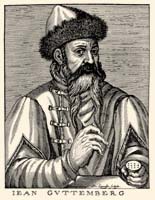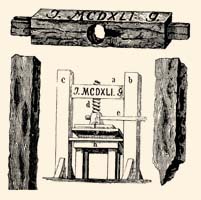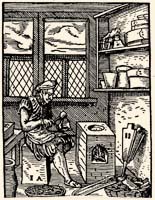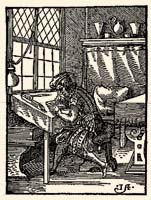As a result of bourgeois development starting in the 13th century, numbers of the literate increased considerably. Literacy, parallel with the social demand for books, was growing considerably, which manual copying was no longer able to meet. Therefore, in the middle of the 15th century there was a clear social need for inventing book printing.
 |
 |
 |
Wood-cut phantasy-portrait of Johannes Gutenberg made after his death |
The image of Gutenberg's supposed printing press |
A detail from Gutenberg's 42-line Bible |

1. THE PROCESS OF BOOK MAKING IN THE HAND-PRESS PERIOD
1.1. Paper manufacturing
|
|
 |
Paper maker (Jost Amman's wood-cut) |
Paper-mill operated with water-raid (17th century illustration) |
Water-mark from the paper used by Gál Huszár in his books printed in Óvár |

2. PUNCH AND MATRIX
|
|
 |
Punch and matrix |
Letter casting instrument |
Letter caster in the foundry (wood-cut by
Jost Amman) |

3. BOOK PRINTING
|
|
Setting |
The letter case used in Debrecen (1697) |
|
|
|
Printer as represented by a contemporary printer's device |
The making of the ink-ball: a leather ball filled with horsehair |
The earliest representation of the press: the printer's device of the French Badius Jodocus Ascensius |

4. HAND PRESSES THROUGHOUT THE CENTURIES
|
|
16th century representation of the press |
Wood-cut illustration decorating the type specimen sheet of a 17th century Nurenberg foundry |
|
|
Copper-plate representation of a printing shop with the press and two printer sin the front. To the left: letter case with the compositor turning his back, and a letter-caster working int he background |
|
|
Representation of a cast-iron press from the early 1800s |
|

5. THE ILLUSTRATION OF BOOKS
|
|
 |
Illustrator at work |
Card painter at work |
wood-cutter at work |

6. BOOK BINDING
|
|
Book-binding workshop
(wood-cut by Jost Amman) |
The tools of book-binding |
|
Reconstructed book-binder's workshop from the hand press period |
<<back on the top<<